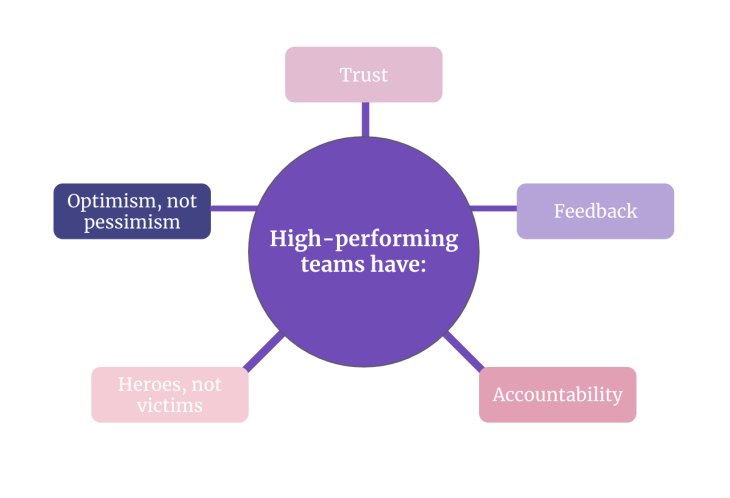The five traits that lead teams to high-performance

Every team is unique. No team is the same.
After working with dozens of teams, I learned why some teams stand out while others get stuck. High-performing teams share common characteristics; whenever they lack them, they trap themselves.
Unfortunately, I cannot promise you a recipe for high performance, but I can share the critical aspects that will make the difference.
Before I elaborate on high performance, I must set the expectations with you. I haven’t found any shortcuts to get a team to this level, and I don’t believe it exists.
It takes years to unleash the team’s true potential. Yet, I’ve found five traits that will increase the odds of getting there, which I’ll share with you in a bit.
A lot is said about high-performing teams, but that will never happen if the environment isn’t ready for it. With a dysfunctional culture, teams cannot reach their highest potential.
It’s hard to say that because it puts teams in passive mode, waiting for the perfect scenario. That’s not what I want for you.
If you identify any of the points I’m about to share, you can foster a change with the right action.
High performance is possible when:
Whenever these elements are present, you’re set to thrive. If you lack any of the points above, feedback is a tool to foster change.
Some of the characteristics I’m about to share can help you transform your scenario if it’s dysfunctional.
Now, let’s understand the differences between high-performing teams and ordinary ones.

The foundation for any team is trust. Without that, teams cannot evolve. Yet, trust isn’t something you can ask for. You must earn it.
“Trust is knowing that when a team member does push you, they’re doing it because they care about the team.” ― Patrick Lencioni, The Five Dysfunctions of a Team: A Leadership Fable
What does trust mean for different teams?
You’ll be shocked by how they interact.
They are unafraid of conflict, and they challenge each other all the time. Looking from the outside, you may think they are fighting and cannot work together. And that’s precisely the difference.
They identify conflicts and solve them as a team as fast as possible.
At first glance, you’ll experience a calm atmosphere.
No one challenges each other. They fear hurting others and carefully choose the words they use. The result is ugly. Unaddressed conflicts remain open and spoken for too long.
Teams move slowly because they’re too cautious with one another.
Trust enables teams to grow, but that alone isn’t enough. The best tool I know for growth is feedback. That’s powerful.
What makes me sad is that many people miss opportunities to help others grow because they lack the skills to give feedback. Leaders tend to hold it for performance reviews. Team members tend to avoid feedback because of different reasons. Here’s my take on it:
There’s no growth without actionable feedback.
What does feedback mean for different teams?
Team members barely miss a chance to give feedback.
Whenever something happens, they give actionable feedback on point and time. They ensure the feedback shows appreciation. It’s based on observation. And it’s actionable.
Beyond giving feedback, high-performing teams know how to receive and ask for feedback. They foster a feedback culture because they want to grow.
Lack of skills to provide and receive feedback.
When giving feedback, team members tend to mix observation and interpretation. This issue leads to resistance when receiving feedback.
Another point is when to give feedback. Unlike high-performing teams, ordinary ones don’t provide feedback right after a situation but wait for weeks or months to share it. That diminishes the effect feedback can have.
Teams cannot succeed until they take full accountability for their actions.
Recognizing the effects of your actions and being accountable for them is powerful. Without that, teams find excuses to justify bad choices.
The combination of trust and feedback enables teams to hold each other accountable for results.
What are the different levels of accountability teams?
In high-performing teams, everyone will hold each other accountable for their results. The atmosphere will look tense from the outside, but inside the team, they all want the best for their collective impact.
Let me give you an example, a team member commits to deliver something in two days. Then in two days, nothing happens. This person will either proactively come to the team and figure out a solution for it, or someone from the team will provide feedback and work on a solution. They take an active role in holding each other accountable.
Accountability with ordinary teams is often absent. They tend to be indifferent to mistakes and not hold up to agreements.
Taking the same example as before, the team member responsible for delivering would not proactively search for a solution when they missed the agreement. Neither would the other team members hold them accountable for it.
Unfortunately, many teams don’t care about accountability. Every team member tries to do their job but ignores the collective result.
Over the last fifteen years, I’ve seen a lot. From Brazil to Germany, from start-ups to massive corporations. I’ve been in different market sectors — public, automotive, fashion, consulting, and more. If I learn something, it’s the following:
Things will always get in the way of doing what you aim for.
It doesn’t matter where you are. The scenario will never be fully favorable to you. That’s normal. But how you deal with it is a vital aspect.
Progress is the ultimate goal of high-performing tools. They recognize their scenario and ask, “What’s the best course of action?” They do what they can at that moment. They don’t complain about what’s missing.
In short, they act as the heroes of their stories, not victims of their circumstances.
High-performing teams don’t take a passenger seat. They adapt according to the situation and play with the cards they have. They always take the driver’s seat and keep progressing towards their goal no matter what.
Adverse situations hit them severely.
Whenever something goes wrong, they become passive. Instead of adapting their course of action, they complain about the situation and take no action.
Ordinary teams let the circumstance define them because they become victims of it.
No matter your business, a leap of faith is required to thrive. Without hope, you have no motivation to keep progressing.
What do you see when you look at a 300ml glass with 150ml? A half-full glass or a half-empty one?
Optimism is a crucial aspect of enabling high performance. A positive mindset will inevitably lead to a positive outcome.
High-performing teams will always see the glass half-full.
They are optimistic. Eventually, things go wrong, but they learn from it and adapt their course of action to keep progressing and reach their goals.
Pessimism and internationalization are part of ordinary teams. They blame outside factors for their poor results.
Whenever an opportunity is presented to them, they start pointing out its negative aspects. They are pessimistic and lack hope for a brighter future. When they work on something that goes wrong, their first reaction is, “I said it before. It would never work.”
They always see the glass half-empty. They complain, externalize, and ultimately get stuck.
Pessimistic people become toxic and discourage others from bringing their best. Inevitably, pessimism becomes a self-fulling prophecy.
No matter where you are right now, you can help your team grow step by step into high performance. You just need to start.
I’ve got a task for you. Look at your scenario, evaluate each aspect, and understand where your team is currently positioned. Share it with them, and have a conversation. Together you can change it.
If you lack the preconditions for high performance, share them with your team lead. Talk about it. All companies want to become more successful. If you’re willing to help, they’ll be ready to listen to you.
Featured image source: IconScout

LogRocket identifies friction points in the user experience so you can make informed decisions about product and design changes that must happen to hit your goals.
With LogRocket, you can understand the scope of the issues affecting your product and prioritize the changes that need to be made. LogRocket simplifies workflows by allowing Engineering, Product, UX, and Design teams to work from the same data as you, eliminating any confusion about what needs to be done.
Get your teams on the same page — try LogRocket today.

Most teams fail at autonomy. Learn how clear rules help product teams move faster without micromanagement.

A practical framework for PMs to use AI in ideation without sacrificing judgment, strategy, or decision quality.

A practical five minute revenue estimation method to help product managers compare ideas, drop low impact features, and prioritize smarter.

A practical guide for PMs who want to stop being bottlenecks, delegate smarter, and lead teams effectively with a clear ownership framework.